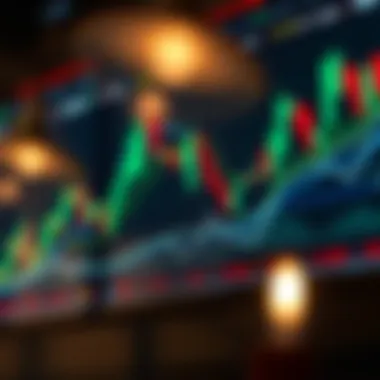Mastering Japanese Candlestick Trading Techniques


Intro
Japanese candlestick trading has been a powerful ally for traders seeking to decode the rhythm of market movements. Originating in 18th century Japan, this methodology has transcended its historical roots, emerging as a cornerstone for technical analysis in various trading environments, including crypto markets. The distinctive visual representation of price action through candlestick patterns not only enhances our understanding but also provides insights into market psychology.
With candlesticks, traders can quickly gauge the mood of the market, capturing essential information in a compact and coherent form. Whether you're just dipping your toes in trading waters or you're someone who has been navigating the tides of finance for years, grasping these concepts is essential for making informed trading decisions.
In this guide, we will traverse the multifaceted world of Japanese candlestick trading, focusing on its fundamental concepts alongside practical applications. We’ll also touch on strategies that blend candlestick analysis with modern trading approaches. Understanding these elements will empower both novice and seasoned traders to harness the full potential of this pivotal trading technique.
Crypto Concepts Explained
Before diving into the depths of candlestick patterns and analysis, it's imperative to establish some foundational terms and concepts associated with both candlestick trading and the cryptocurrency landscape.
Key Terminology and Definitions
- Candlestick: A graphical representation in trading that shows the high, low, open, and close prices of an asset within a specific time frame.
- Bullish: Indicates that the price of an asset is expected to rise.
- Bearish: Signals that the price of an asset is anticipated to decline.
- Doji: A candlestick pattern where the open and close prices are very close to each other, often signaling indecision in the market.
- Engulfing Pattern: A two-candle pattern where the second candle completely engulfs the first, indicating a potential reversal in market direction.
Gaining familiarity with these terms is crucial for making sense of candlestick charts, especially in the fast-paced world of cryptocurrency trading.
Practical Applications of Candlestick Trading
Candlestick trading offers numerous practical applications that can be successfully employed in various trading strategies:
- Market Sentiment Analysis: By examining candlestick formations, traders can gauge whether the market is leaning towards bullish or bearish sentiment, helping in making decisions such as when to enter or exit trades.
- Trend Identification: Recognize whether an asset is trending upward, downward, or is in a consolidation phase, allowing for better positioning.
- Signal Confirmation: Use candlestick patterns in conjunction with other indicators, like moving averages or RSI (Relative Strength Index), to confirm trading signals and enhance accuracy.
The unique visual cues offered by candlestick patterns can undoubtedly refine a trader's strategy, especially when dealing with the unpredictable nature of cryptocurrencies.
In trading, understanding the tools and concepts is half the battle won. Candlestick patterns help bring much-needed clarity to the sometimes overwhelming flood of data.
In the next sections, we will explore investment strategies that incorporate candlestick trading, helping you navigate market trends and manage risks more effectively. By building upon the knowledge of these concepts, readers will be well-equipped to advance their trading endeavors.
Preface to Japanese Candlestick Trading
Japanese candlestick trading stands as one of the most visually intuitive approaches to market analysis. This method, with origins that stretch back to 18th century Japan, provides traders not only with a glance at market sentiment, but also with a deeper understanding of potential price movements. Beyond just mere bars on a chart, these candlesticks encapsulate the psychology of traders, making them an essential tool for anyone stepping into the world of trading.
Historical Context
The art of candlestick charting emerged from the rice markets of Japan, particularly by a man named Munehisa Homma, who was both a rice trader and a pioneering chartist. As the story goes, Homma focused on capturing the emotions driving market behavior through these patterns, laying the groundwork for what would become a crucial trading framework. It’s fascinating to note that candlesticks were not merely functional tools; they intertwined deeply with the philosophies of Japanese culture at the time. Traders would observe not just the numbers but also the narratives behind them—much like a storyteller weaving a tapestry of price action.
As markets evolved and technology changed the way information was disseminated, the candlestick’s principles remained. Its structures have been adapted for various assets, including stocks, forex, and cryptocurrencies, making it relevant in today's digital trading world. The importance of understanding this historical backdrop cannot be understated; it emphasizes the rich tradition and methodology embedded in candlestick trading.
Why Candles? The Importance of Visualization
When diving into the world of financial charts, clarity becomes key. One primary reason traders favor candlestick charts over traditional line charts is the enhanced visualization they offer. A single candlestick provides a snapshot of price action over a specified time frame, capturing essential information—open, close, high, and low— in a compact visual format.
Consider the following aspects of candlestick charts:
- Intuitive Interpretation: The color and body length of a candlestick convey immediate sentiment. A long green candle might signal a strong buying trend, while a short red one could indicate indecision or bearish sentiment.
- Pattern Recognition: Traders often depend on recognizable patterns such as Dojis or Hammers. These formations become more accessible when viewed in candlestick format, allowing for quicker decision-making.
- Psychological Insights: The visual format helps traders to gauge market psychology. Are buyers dominating? Or are sellers pushing prices down?
The ability to visualize and interpret market information quickly is paramount. Ideally, this visualization fosters not only a better understanding of price behavior but also enhances one’s ability to anticipate shifts in market sentiment. Ultimately, mastering candlestick charting allows traders to respond strategically rather than emotionally, leading to more informed trading decisions.
"Understanding psychological themes and price patterns transforms a trader from a spectator into an active participant in market dynamics."
In sum, the journey into Japanese candlestick trading is as much about understanding market psychology as it is about reading charts. With its historical context and emphasis on visualization, this methodology is not just a technical skill, but a refined art aimed at unlocking the mysteries of market behavior.
Understanding the Basics of Candlestick Charts
Understanding candlestick charts goes beyond just knowing how to read them; it’s about grasping their power in visualizing market sentiment and price behavior. Candlestick charts are pivotal in trading because they provide a more detailed view of price movements compared to traditional line charts. By delving into their components and types, traders can cultivate an informed approach that aligns with market dynamics.
Components of a Candlestick
Open, Close, High, Low


The four pillars of every candlestick are the open, close, high, and low prices. The open price refers to the first transaction price within a trading period, while the close price marks the last transaction. These two numbers are fundamental in defining the candle's body. Moreover, the high and low indicate the maximum and minimum prices for that time frame.
- The interplay of these four values gives traders insight into buyer and seller motivations.
- For instance, when the close price is above the open, it signifies that demand has overpowered supply.
- A quick glance at these values helps traders to determine potential market trends and reversals. Therefore, understanding them is crucial for accurate decision-making.
Body and Wick
The body of the candlestick comes alive with the difference between the open and close prices. A thicker body suggests robust price movement, signalling stronger momentum in either direction. The wick or shadow, which extends above and below the body, illustrates the highest and lowest traded prices, providing context on price volatility.
- Bodies can vary in size, reflecting the strength or weakness of price action during the period.
- A long wick with a small body indicates indecision, meaning that traders were reluctant to commit in one direction.
- Recognizing these characteristics helps traders gauge market enthusiasm and hesitation, making body and wick a vital aspect of candlestick analysis.
Color Significance
Color plays a significant role in the interpretation of candlestick charts. Generally, green or white candles indicate bullish momentum—where the closing price is above the opening price—whereas red or black candles show bearish momentum.
- This color distinction provides immediate visual cues that can influence trading behavior.
- For example, a large green candle followed by a small red one might suggest a reversal or weakening of momentum.
- Though the colors give quick insights, they shouldn't be the sole consideration; practitioners must also analyze the full context of patterns and trends.
Types of Candlesticks
Single Candlestick Patterns
Single candlestick patterns, such as the Doji or Hammer, reveal critical market signals. These patterns often reflect buyer-seller indecision or potential reversals. They are fundamental for traders because they present a straightforward method for interpreting the market.
- Recognizing single candlestick patterns is pivotal as they can indicate entry or exit points based on short-term trends.
Multiple Candlestick Patterns
Multiple candlestick patterns, like the Engulfing or Evening Star, often demonstrate more complex sentiments in the market over several time frames. These patterns provide insights into market psychology by showing how previous price movements influence future behavior.
- The benefit of incorporating these patterns into trading strategies lies in their predictive potential. They showcase shifts in sentiment, which may not be visible with single candles alone.
Continuation vs Reversal Patterns
Finally, the understanding of continuation and reversal patterns is essential to developing robust trading strategies. Continuation patterns signify that the underlying trend is likely to continue, while reversal patterns flag a shift in market direction.
- Recognizing these distinctions allows traders to align their strategies with prevailing trends or adjust for potential reversals, making them integral for effective trading.
In essence, the study of candlestick components and patterns is not just for analytical rigor; it's to empower traders with the skills necessary to navigate the complex world of trading with more confidence.
Key Candlestick Patterns and Their Interpretations
In the realm of Japanese candlestick trading, understanding key patterns and their interpretations is crucial for deriving actionable insights. Each candlestick pattern encapsulates information about market sentiment, which can be pivotal in predicting future price movements. As traders navigate through market fluctuations, recognizing these patterns can provide a clearer picture of potential reversals or continuations. This understanding can sharpen one's ability to make informed decisions, ultimately leading to better trading outcomes.
Doji: A Sign of Market Indecision
The Doji candlestick pattern is a significant signal often observed in various market conditions. Characterized by its small body and elongated shadows, a Doji signals a period of indecision among traders. When a Doji forms, it indicates that the opening and closing prices are nearly equal, which reflects a lack of conviction in the market. The interpretation here is straightforward; it’s a moment where buyers and sellers are at a stalemate.
A Doji appearing after a strong trend can be particularly telling. For instance, if it emerges after a bullish rally, it may suggest that buying pressure is waning and a potential reversal could be on the horizon. Conversely, if it follows a bearish movement, it might signify that the downward trend could be losing steam. However, traders should be wary and seek confirmation through subsequent candlesticks or other indicators before acting.
Hammer and Hanging Man: Reversal Signals
The Hammer and the Hanging Man are distinct patterns, but both serve to signal possible market reversals. The Hammer appears after a downtrend and resembles a hammerhead, with its small body at the top and a long lower shadow. This pattern suggests that despite sellers pushing prices lower, buyers stepped in powerfully enough to drive the price back up, indicating potential bullish momentum.
On the other hand, the Hanging Man appears after an uptrend and has a similar shape to the Hammer. It indicates that even though the price reached a higher level, sellers are beginning to gain strength, potentially signaling a reversal to the downside. Both patterns require confirmation from subsequent trades before making any solid trading decisions. Watching the volume can also provide additional insights into the strength of either signal.
Engulfing Patterns: Bullish and Bearish Trends
Engulfing patterns, comprising two candlesticks, can signal significant trend reversals. There are two types: the bullish engulfing and the bearish engulfing patterns. A bullish engulfing pattern forms when a smaller bearish candle is completely engulfed by a larger bullish candle. This pattern suggests that buyers have overtaken sellers, indicating a potential reversal from a downtrend to an uptrend.
Conversely, a bearish engulfing pattern forms when a smaller bullish candle is swallowed by a larger bearish candle. Here, sellers are overpowering buyers, hinting at a reversal from bullish to bearish sentiment. These patterns often carry weight but require a comprehensive approach—considering other technical indicators or the context of the larger market trend can provide additional confirmation.
Morning Star and Evening Star: Strong Reversals
The Morning Star and Evening Star patterns are powerful three-candle formations that represent a shift in sentiment. The Morning Star, appearing at the end of a downtrend, consists of a long bearish candle, followed by a small-bodied candle (which may be bullish or bearish), and culminates in a long bullish candle. This pattern indicates that after a period of weakness, bullish momentum is beginning to take hold.


On the flip side, the Evening Star emerges at the peak of an uptrend and is composed of a long bullish candle, a small-bodied candle, and a long bearish candle. It suggests that sellers are finally taking control after a bullish period. Both of these patterns are not just visual cues; they represent significant shifts in market dynamics and should be treated as such.
Overall, recognizing these key candlestick patterns equips traders with insights into market sentiment and potential price actions. Utilizing these tools effectively in conjunction with analytical strategies lays a solid foundation for making informed trading decisions.
Analyzing Market Sentiment through Candlestick Patterns
Analyzing market sentiment is at the heart of successful trading, and candlestick patterns serve as a powerful tool in this process. Understanding how traders feel about a particular asset can provide significant insights into market movements. Smart investors know that it’s not just about numbers on a chart; emotions and psychology play a crucial role in influencing price action. Through candlestick patterns, one can gauge this sentiment, which can ultimately inform their trading strategy.
Psychological Themes in Trading
The human element in trading is often overlooked, yet it’s the driving force behind market changes. Psychological themes manifest in various ways, and these emotions can be identified through candlestick formations. For instance, when traders see prolonged price drops, fear often sets in. This fear can create a series of bearish candles, suggesting that sellers are dominating the market. Conversely, a sequence of bullish candles might indicate that hope and optimism are driving demand, hinting at potential upward momentum.
Understanding these psychological themes can help traders identify when the sentiment is shifting. For example, a Doji candle, which shows indecision, might indicate that traders are caught between optimism and pessimism. Recognizing such moments allows a trader to make more informed decisions. Overall:
- Fear can lead to market sell-offs.
- Greed can create buying frenzies.
- Indecision can pave the way for reversals.
By keeping a keen eye on these psychological indicators, you can fine-tune your entry and exit points, making more calculated moves in a highly volatile market.
The Role of Volume in Candlestick Analysis
Volume is often referred to as the lifeblood of the market. It provides context to the candlestick patterns you observe and serves as a reliable confirmation tool. When a candlestick is formed on high volume, it signals strong conviction behind that price movement. On the other hand, a candle formed with low volume may not carry the same weight, making predictions less reliable.
For instance, if a bullish engulfing pattern emerges while the trading volume spikes, it suggests robust buying interest, thereby increasing the reliability of the pattern. If that same pattern appears with weak volume, it may indicate that the rally lacks support, making it suspect.
Key Takeaways on Volume:
- High Volume: Confirms the strength of the price movement.
- Low Volume: Signals potential reversals or lack of conviction.
- Volume Trends: Looking for increasing or decreasing trends in volume can also provide insight into market sentiment.
Integrating Candlestick Analysis with Other Technical Indicators
To really make headway in the world of trading, and especially with Japanese candlestick patterns, it’s crucial to look beyond just those candlesticks themselves. Integrating candlestick analysis with other technical indicators can significantly boost your trading strategy. This blends the art of interpreting candlesticks with more analytical tools to give a fuller picture of market trends and various trading signals. Each indicator adds its own layer of understanding, enabling traders to make better-informed decisions.
Moving Averages: Confirming Trends
Moving averages act as a smoothing agent for price data, allowing traders to identify the direction of the trend clearly. When applied to the analysis of candlestick charts, their primary role is to confirm what the candlesticks are suggesting. For example, if a trader observes a bullish candlestick pattern but finds that the price is still below the moving average, it would raise a red flag.
On the other hand, if a bullish pattern aligns with a rising moving average, this could confirm an upward trend, increasing the likelihood of a successful trade.
Here’s how to effectively use moving averages with candlestick patterns:
- Short-Term vs. Long-Term: Use short-term moving averages like the 5 or 10-day to spot immediate trends, while longer averages, such as the 50 or 200-day, help to identify more stable trends.
- Crossovers: Pay attention to crossovers where a short-term moving average crosses above a long-term one, signaling potential buying opportunities or vice versa for selling.
Relative Strength Index: Gauging Momentum
The Relative Strength Index (RSI) is a momentum oscillator that measures the speed and change of price movements. In the context of candlestick trading, it serves as an essential tool for confirming whether recent price movements are sustainable or likely to reverse. An overbought or oversold RSI can help traders decide when to enter or exit a trade.
- Confirming Patterns: If a candlestick pattern signals a potential trend reversal, checking the RSI can add credibility to that signal. For example, if a trader sees a bearish engulfing pattern and an RSI above 70, it may indicate that a drop is likely. In contrast, a bullish formation combined with an RSI dipping below 30 could suggest a solid potential for upward movement.
- Divergence: Divergences between the RSI and price—when the price reaches higher highs but the RSI doesn’t—can also signal trend exhaustion, adding another layer of insight beyond candlesticks alone.
Combining Fundamental Analysis with Candlesticks
Candlestick analysis, when merged with fundamental analysis, provides traders with a robust framework for making decisions. Fundamental analysis looks at the larger economic factors and fundamentals that can impact a security’s price. However, it can sometimes fall short without the visual aspects that candlesticks offer.
By fusing these two methods, traders can ground their technical setups in solid, fundamental reasoning. For instance:
- Market Sentiment: Candlestick patterns can reflect immediate reaction to news. If a company reports underwhelming earnings resulting in a bearish candlestick pattern, understanding the reason behind this move is crucial.
- Event Timing: Traders might slot their trades around significant economic events—like interest rate announcements or employment reports—while using candlestick patterns to find entry and exit points.
Practical Application: Designing a Trading Strategy
Creating a trading strategy based on Japanese candlestick patterns involves more than just looking for shapes on a chart; it's about laying a strong foundation for your trades. This strategic design becomes a guide through the often unpredictable realm of financial markets. It helps investors, analysts, and enthusiasts to engage in informed decision-making, minimizing the guesswork involved in trading. A solid strategy not only helps in identifying potential entry and exit points but also in establishing a structure for risk management and performance evaluation.
Having a well-thought-out plan allows you to navigate the tumultuous waves of market sentiment with clarity. You can hone in on patterns that give vital clues about impending price movements, ensuring you don’t miss golden opportunities. Moreover, a tailored trading strategy brings a sense of discipline; discipline fosters consistency, which is essential in the pursuit of profits.


Setting Entry and Exit Points
Establishing where to enter and exit trades is like drawing the lines on a canvas before you begin painting. The entry point is crucial, as this is where your trade will start to take form. Look for high-probability candlestick patterns, like the bullish engulfing, to signal strong buying pressure. This is often characterized by a larger body of a green candle engulfing the previous red candle.
When determining exit points, consider implementing trailing stops or fixed-risk ratios. A common approach is to use the high or low of the candlestick that signaled your entry as a guide. Setting these levels will allow you to lock in profits while providing room for the trade to develop.
Ultimately, consistently using these strategies will sharpen your instincts over time:
- Analyze past performance to adjust your entry criteria.
- Forward test new strategies in a demo account before committing real capital.
Risk Management Techniques
Risk management is akin to wearing a safety belt while driving; it’s essential for protecting your investment. The first key principle is to determine how much of your total capital you are willing to risk on a single trade. A common guideline is to limit risk to 1-2% of your total trading capital. This ensures that no single loss can significantly impact your financial standing.
Additionally, implementing stop-loss orders based on candlestick patterns can be effective. For instance, if you enter a position on a signal from a hammer candlestick, consider placing a stop-loss just below its low. This tactical placement aligns with your trading setup and protects you from adverse price movements.
Consider the risk/reward ratio as well. Aiming for a minimum ratio of 1:2 or 1:3 ensures that the potential gain on a trade significantly outweighs the loss you are willing to risk.
Maintaining a Trading Journal
A trading journal is your best friend on the road to becoming a seasoned trader. It's not just an account of what trades you took, but a valuable tool for self-reflection and strategy refinement. Every successful trader keeps one, documenting the reasons behind each trade, entry and exit points, and outcomes.
When you jot down your thoughts, consider the emotions you felt during different phases – anticipation before execution, elation after a win, or regret after a loss. Doing this helps identify psychological patterns that may impact your trading decisions.
Furthermore, uncluttered records of your performance can also aid in identifying which candlestick patterns yield the best results over time. Here’s how to structure your journal:
- Date of trade
- Type of candlestick pattern
- Entry and exit points
- Position size
- Outcome (profit/loss)
- Notes on what to improve next time
Reflecting on your decisions and analyzing journal entries over weeks and months will help enhance your strategy. As you progress, you’ll not only gain insights into your trading style but also refine your technique, resulting in more informed trading decisions.
Common Mistakes to Avoid in Candlestick Trading
Understanding the pitfalls in candlestick trading is vital for both new and seasoned traders. Many investors jump into the market with a sense of excitement, but not recognizing common mistakes can lead to financial missteps. Avoiding these blunders helps to build a solid foundation for long-term success. This section discusses two major mistakes that traders often encounter: overtrading based on misinformation and ignoring market news and events.
Overtrading Based on Misinformation
One of the most compelling traps for traders is overtrading based on misleading information. The market is flooded with opinions, signals, and advice which may not be accurate. This saturation can lead traders to make hasty decisions, often born from excitement rather than sound analysis. Overtrading happens when a trader attempts to capitalize on too many perceived opportunities, driven by emotions or external social influences.
- Consequences of Misinformation:
Overtrading usually leads to increased transaction costs and can place undue stress on one's account. Many traders may find themselves in a tailspin, constantly chasing losses or trying to manage unplanned risk. - Recognizing Reliable Sources:
To avoid falling into this trap, it’s essential to dissect the sources of trading signals. Investors should seek out trusted platforms and knowledgeable individuals. Forums like Reddit can sometimes contain valuable insights, but it's crucial to distinguish between informed commentary and mere speculation.
Ignoring Market News and Events
Neglecting to stay updated on significant market news and economic events can be another costly mistake. The relevance of economic indicators, political events, and global occurrences cannot be overstated. These factors can have an immediate impact on market sentiment and influence the effectiveness of candlestick patterns.
- Staying Informed:
Proactive traders pay attention to news alerts and economic calendars to anticipate potential market movements. Discussions on platforms like Facebook can help gather diverse perspectives, especially regarding upcoming events that may sway market direction. - Understanding Correlations:
An awareness of how specific news impacts currency pairs or securities can enhance one's trading strategy. For instance, if a company's earnings report drastically underperforms expectations, it may lead the stock to show a bearish candlestick pattern, indicating a potential downturn.
By being keenly aware of these common missteps, traders can enhance their approach to candlestick trading significantly, leading to greater investment success.
"Success in trading is not just about finding the right entry points, but also about avoiding the pitfalls that derail most traders."
This understanding propels traders towards better decision-making and ultimately a more robust trading strategy.
End: Mastering Japanese Candlestick Trading
Navigating the world of trading can often feel like balancing on a tightrope, where a single misstep can lead to significant losses. This is where mastering the art of Japanese candlestick trading comes into play. Understanding candlestick formations provides traders with a clearer lens through which to view market movements and trends. A solid grasp of these tools aids in deciphering the often chaotic nature of price action and instills confidence in decision-making processes.
Recap of Key Takeaways
As we draw this comprehensive guide to a close, let's recap some of the key elements:
- Historical Significance: Japanese candlestick trading has deep historical roots that date back centuries, offering more than just a visual tool–it embodies a rich tradition of market analysis.
- Essential Components: Familiarity with candlestick components such as open, close, high, and low is vital. Each aspect provides clues to market sentiment and potential price movement.
- Important Patterns: Recognizing patterns like Doji, hammer, and engulfing shapes can signify critical market reversals or continuations, serving as beacons in uncertain waters.
- Psychological Insight: The interplay of psychology in trading, highlighted through candlestick patterns, reveals the collective mindset of market participants and their behaviors, which is essential for traders to comprehend.
- Combining Strategies: Successful trading often relies on blending candlestick analysis with other technical indicators, such as moving averages and the Relative Strength Index, enhancing the accuracy of predictions.
In essence, these takeaways shape a sturdy foundation for both novice and seasoned traders, encouraging them to utilize these insights to refine their strategies.
Encouragement to Continue Learning
Mastery of candlestick trading does not happen overnight. It's an ongoing journey, requiring continuous education and adaptation to market dynamics. Each trading day presents a fresh canvas, a new opportunity to implement learned strategies and observe their effectiveness.
- Dive Deeper: Engage with resources such as online courses, seminars, and forums (like those found on Reddit) that allow for deeper exploration into candlestick analysis and broader trading strategies.
- Join Communities: Connecting with fellow traders builds your knowledge base, exposes you to fresh perspectives, and helps you remain motivated.
- Reflect and Adapt: Analyze your trades, maintain a trading journal, and adjust strategies as needed based on outcomes. Learning fundamentally means growing from experience.















